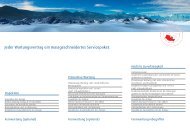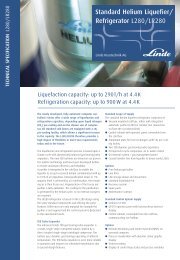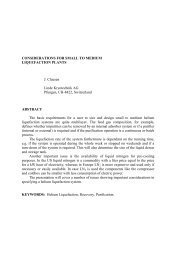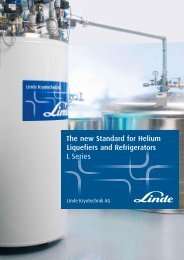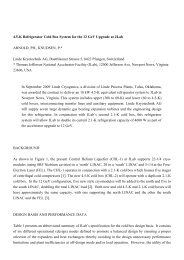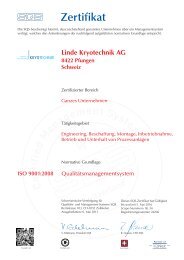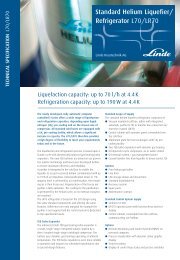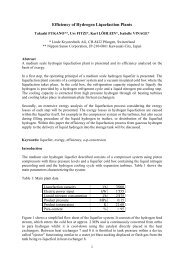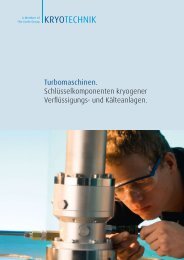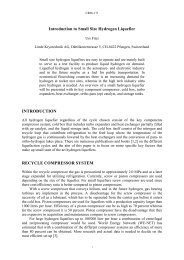nasa - james webb telescope - bei Linde Kryotechnik AG, Schweiz
nasa - james webb telescope - bei Linde Kryotechnik AG, Schweiz
nasa - james webb telescope - bei Linde Kryotechnik AG, Schweiz
Create successful ePaper yourself
Turn your PDF publications into a flip-book with our unique Google optimized e-Paper software.
LARGE SCALE REFRIGERATION PLANT FORGROUND TESTING THE JAMES WEBBTELESCOPE AT NASA JOHNSON SPACE CENTERP. Arnold 1 , Lutz Decker 1 , D. Howe 2 , J. Urbin 2 , Jonathan Homan 3 , CarlReis 4 , J. Creel 5 , V. Ganni 5 , P. Knudsen 5 , A. Sidi-Yekhlef 51 <strong>Linde</strong> <strong>Kryotechnik</strong> <strong>AG</strong>Pfungen, CH-8042, Switzerland2 <strong>Linde</strong> Cryogenics, Division of <strong>Linde</strong> Process Plants, Inc.Tulsa, Oklahoma, USA3NASA, Johnson Space Center, Texas, USA4Hamilton Sundstrand, Engineering and Science Contract Group,NASA Johnson Space Center, Texas, USA5Thomas Jefferson National LaboratoryNewport News, Virginia, USAABSTRACTThe James Webb Telescope is the successor to the Hubble Telescope and will beplaced in an orbit of 1.5 million km from earth. Before launch in 2014, the <strong>telescope</strong> willbe tested in NASA Johnson Space Center’s (JSC) space simulation chamber, Chamber A.The tests will be conducted at the deep space conditions of low pressure and temperature.Chamber A’s helium cryo-panels are currently cooled down to 20 K by two <strong>Linde</strong> 3.5 kWrefrigerators. The new 12.5 kW, 20 K Coldbox described in this paper is part of theupgrade to the chamber systems for this large test program. The <strong>Linde</strong> Coldbox willprovide refrigeration power in several operating modes where temperatures andrefrigeration power are controlled with high accuracy due to the demanding NASA testrequirements. The implementation of two parallel expansion turbine strings and the Gannifloating pressure cycle results in a highly efficient and flexible process that reduces theelectrical power input. This paper will describe the collaboration and execution of theColdbox project.
KEYWORDS: Large Scale Refrigerator, Floating Pressure, NASAINTRODUCTIONJames Webb TelescopeThe James Webb Space Telescope (JWST) will be a large infrared <strong>telescope</strong> with a6.5-meter primary mirror. Launch is planned for 2014.JWST will be the premier observatory of the next decade, serving thousands ofastronomers worldwide. It will study every phase in the history of our Universe, rangingfrom the first luminous glows after the Big Bang, to the formation of solar systems capableof supporting life on planets like Earth, to the evolution of our own Solar System.JWST is an international collaboration between NASA, the European SpaceAgency (ESA), and the Canadian Space Agency (CSA). The NASA Goddard Space FlightCenter is managing the development effort. The prime contractor is Northrop Grumman;the Space Telescope Science Institute will operate JWST after launch.Several innovative technologies have been developed for JWST. These include afolding, segmented primary mirror, adjusted to shape after launch; ultra-lightweightberyllium optics; detectors able to record extremely weak signals, microshutters that enableprogrammable object selection for the spectrograph; and a cryocooler for cooling the mid-IR detectors to 7 K. The long-lead items, such as the beryllium mirror segments andscience instruments, are under construction. All mission enabling technologies weredemonstrated by January 2007, and the Project was confirmed to enter its implementationphase in July 2008.Refrigerator and Space Simulation Test ChamberJSC space simulation chamber, Chamber A, is <strong>bei</strong>ng prepared to test the JWSTObservatory. The Observatory consists of the primary optics called the OTE (OpticalTelescope Element) and the science instrument package called ISIM (Integrated Scienceand Instrumentation Module). The primary objective is to test the OTE in its flight likeenvironment. The OTE test will align and focus the 18 mirror segments at cryogenicconditions, verify and measure the cryo-positioning of the mirror structure to see theintegrated full optics act as a monolith at cryogenic temperatures. The OTE and ISIMtesting will verify the integrated path of the light through the primary mirrors to the scienceinstruments. Another objective of the test will be thermal balancing to simulate the thermalperformance on flight and to correlate the observatory thermal models. To create therequired deep space environment, Ch-A at the Johnson Space Center is undergoing largescale modifications. A new gaseous helium cooled shroud will be installed in the chamber.The new refrigerator will provide the active cooling (
PROJECT EXECUTIONNASA and the US Department of Energy agreed to have Jefferson National Lab’s(JLab) cryogenics experts consult on the helium refrigerator Chamber A upgrade for theJWST test program. JLab is consulting to NASA and Jacobs Engineering for the systemdesign, system integration, and controls. Jacobs Engineering awarded the Coldboxcontract <strong>Linde</strong> Cryogenics. Coldbox engineering and startup support will be performed by<strong>Linde</strong> <strong>Kryotechnik</strong>. Coldbox fabrication, testing, and installation support will be performedby <strong>Linde</strong> Cryogenics. Process engineers from JLab and <strong>Linde</strong> are cooperating under the<strong>Linde</strong> license of the “Ganni Floating Pressure Cycle” to optimize the process and controlsfor the new plant. The Coldbox is scheduled to be delivered to NASA JSC early in 2010.PROCESS DESIGNRefrigerator Design CriteriaThe refrigeration plant was designed to provide the required refrigeration power withgood efficiency over a wide temperature range. The JWST test requirements are underdevelopment and the anticipated load at 20 K is between 8 kW and 12 kW. The mainfeatures of the refrigerator are: Two parallel TED45 turbines provide optimal refrigeration performance in the 100 Krange as well as in the 20 K range. A large LN2 vessel, two parallel warm end heat exchangers and three load returnvalves at different temperature stages ensure an effective large cool down capacity. Two parallel 80 K charcoal adsorbers and a subsequent bypass line are used to purifythe circulating helium before the actual cool-down of the chamber when the turbinesare started. Additional cold gaseous nitrogen supports the first helium / nitrogen heat exchangerwhich results in a lower LN2 consumption.Process ArrangementThe Process Flow Diagram in FIGURE 1 shows a simplified concept of the processarrangement. Warm high pressure helium enters the Coldbox and is divided into twostreams that are <strong>bei</strong>ng cooled down by the low pressure return flow and the nitrogen vaporrespectively. Connected to one stream again the high pressure helium is cooled down to 80K in the nitrogen evaporator before it passes one of the two parallel adsorbers. Beingfurther cooled down in the subsequent heat exchangers the helium is expanded in one ortwo turbines, depending on the temperature range and fed to the Space Chamber. The lowpressure helium return joins the process at 20 K, 80 K or 300 K level depending on itstemperature.
FIGURE 1: Process Flow DiagramFloating Pressure ConceptIt is not unusual that the primary design conditions “Refrigeration Load” and “LoadReturn Temperature”, given by the customer, vary in a considerable range not only in thesales phase but also during project execution as not all impact variables are known in thebeginning. To be on the safe side a “worst case scenario”, via highest load and coldesttemperature is defined to specify the demand for the refrigerator. Hence the systemconsisting of refrigerator, compressor(s) and load must possess sufficient flexibility to copewith all scenarios in an efficient way. The Ganni Floating Pressure Cycle, well described in[1 & 2] is a useful control strategy to provide this flexibility and energy saving potential.The implementation of the floating pressure theory to the existing 3.5kW system at NASA,
JSC and the resulting gains are presented in [3]. Its limitations in actual built plants arepointed out below.Basis for the System Efficiency and Exergy AnalysisThe intrinsic fluid property “(mass)specific exergy” is defined ase h T0 s ,where h is the specific enthalpy, s is the specific entropy and T 0 is the ambienttemperature.The exergy flow between two states 1 and 2, used to quantify the process efficiency,is defined as E mh1 h2T0s1 s2The exergetic efficiency of the Coldbox ex, CBXcan then be defined as the ratio of theexergy flow leaving the Coldbox at the cold end and the exergy flow into the Coldbox atthe warm end.ex,CBXEEHE,WARMHE,COLD EN 2Most interesting for the operator of the refrigeration system however is the exergeticefficiency of the entire system , including the energy power input for the recycleex, SYScompressor and for the production of liquid nitrogen. These input powers are characterizedby efficiencies of compressor and LN2 suppliers gained on numerous executed projectsand can be used to define the system efficiency asex,SYSEEHE,WARMis,COMPHE,COLDEN 2ex,LN 2For the NASA project the isothermal efficiency of the compressor, between 0.4 and0.55 depending on the pressure ratio, is defined in the customer’s specification [4] as wellas the exergetic efficiency for the LN2 production <strong>bei</strong>ng 0.35.System Efficiency and Boundaries of the Floating Pressure ConceptApart from the design conditions T-s-diagrams for various different load cases werecalculated in order to obtain information about the efficiency behavior depending on theload cases. Exemplarily various constraints of the floating pressure concept are shown.
FIGURE 2: 100% Loads at Various Load Return TemperaturesIn FIGURE 2 the refrigeration loads and efficiencies at different load returntemperatures are shown. The exergetic system efficiency is expected to be between 24%and 30% in the large temperature range between 17 K and 100 K. For lower temperaturesthe efficiencies and possible refrigeration loads reduce drastically as the turbine reaches itsaxial thrust restriction. An interesting observation is that there is a local efficiencyminimum in the 80 K range. That is when the LN2 pre-cooling stage is least effective. Forload return temperatures higher than 80 K a significantly higher LN2 consumption isrequired in order to maintain the turbines inlet temperature at 80 K, which is boosting thesystem performance in turn.FIGURE 3: Turndown Modes at 20K Load Return TemperatureIn FIGURE 3 the turndown modes or partial loads at the design load returntemperature of 20 K are shown. The exergetic efficiency is expected to be high and stablefor as low as 50% of the maximal load at this temperature. For lower refrigeration loads theefficiency decreases because the suction pressure of the compressor shall not be subatmospheric. The residual mass flow that is not necessary for the refrigeration load has tocirculate in the compressor bypass. Furthermore the high pressure of the compressor outletshall not fall below 8 bar to ensure proper functioning of the oil removal system.
FIGURE 4: Turndown Modes at 100K Load Return TemperatureIn FIGURE 4 the turndown modes or partial loads at the off-design load returntemperature of 100 K are shown. As an option also the use of only one expansion turbineinstead of two as recommended is shown. The exergetic efficiency is expected to be highand stable for as low as 50% of the maximal load at this temperature when two turbines arein use. For lower refrigeration loads and particularly for operation of only one expansionturbine the efficiency decreases because of a high pressure ratio restriction of theturbine(s). The pressure ratio also contributes to the axial thrust which limits theperformance of the large turbines. The use of only one expansion turbine does notautomatically lead to 50% of the refrigeration load. Because of the mentioned pressureratio constraint the low pressure (respectively turbine outlet pressure) has to be increased.PROCESS CONTROLThe process control of the cold box is based on the Ganni floating pressure cyclephilosophy (simplified schematic: FIGURE 5). As the floating pressure process is aconstant pressure ratio and variable gas charge process, the compressor discharge pressureis adjusted to match the required load as indicated by the shield return temperature. Ofcourse, the minimum compressor discharge pressure is constrained by the design of the oilremoval system and the maximum by the system design pressure (i.e., the pressure ratingof the compressor and components downstream of the compressor discharge).Additionally, there may be other compressor constraints, such as preventing the suctionfrom becoming sub-atmospheric (e.g., for rotary screw compressor designs using a suctionshaft seal). Turbine constraints such as maximum tip speed and bearing capacity arenormally handled by the local turbine control elements (i.e., inlet and brake valves). Theseare set so as to allow the widest possible operational envelope for the turbine. The FloatingPressure process typically utilizes two control elements to add or remove gas charge fromthe system; namely the ‘mass-in’ (MI) and ‘mass-out’ (MO) control valves, respectively.The compressor bypass valve operates only to prevent a sub-atmospheric suction condition.As such it is normally closed, except under greatly reduced loads (i.e., less thanapproximately 50% of the maximum load) or in cases of manual intervention (e.g., such asrequired in a single turbine operation at 100 K for maximum capacity due to a turbinepressure ratio limitation). During steady (fixed temperature) operation, additionalmeasures of capacity control, such as turbine bypass, are not implemented until thecompressor suction pressure reaches its minimum allowed setting (say, 1.05 bar). During acool down to a desired shield return temperature set-point, the discharge pressure remainsat its maximum limit , until the load return temperature reaches the given set-point (say, 20
K). Upon reaching the set-point, the MI and MO adjust the discharge pressure to maintainthe desired shield return temperature so that the refrigeration capacity matches the actualheat load.Liquid nitrogen (LN2) is used for pre-cooling the high pressure helium streamdown to 80 K. The LN2 pre-cooler implements nitrogen phase-separation using a thermosiphonand directs the total high pressure helium flow through the latent nitrogen heatexchanger section. The LN2 supply maintains a pre-determined liquid level set-point inthe phase-separator vessel (i.e., the ‘LN2 pot’). The usage of the LN2 is regulated by thehigh-pressure helium bypass between the large 300-80 K helium-helium heat exchangerand the smaller 300-80 K helium-nitrogen vapor heat exchanger. This valve uses thewarm-end helium-helium stream temperature difference as the primary process variable toaffect minimum LN2 usage. Cascade control is implemented on this valve to prevent thewarm-end helium-nitrogen vapor stream temperature difference from becoming tooextreme (say, a 240 K nitrogen vent temperature).FIGURE 5: Floating pressure control schematicSUMMARYThe system is designed to meet the needs of flexible load (both in meeting the actualload and the required operational temperature for the experiment) with good efficiencies.However, it is important for the supplier of cryogenic plants to receive as much
information as possible in the early phases of a project in order to design the process andparticularly the expansion turbines to achieve optimal results in the most relevant loadcases. In addition the floating pressure philosophy is expected to provide improvedtemperature stability and the reliability as proven in other systems operating under thisprinciple, and these are of critical importance to this system.ACKNOWLEDGEMENTSThis work is a co-operation of NASA JSC, Jacobs Engineering, HamiltonSundstrand, Jefferson Lab, <strong>Linde</strong> Cryogenics, Division of <strong>Linde</strong> Process Plants, Inc. and<strong>Linde</strong> <strong>Kryotechnik</strong> <strong>AG</strong>. We thank all of the many people who are contributing to thesuccess of this project.REFERENCES1. Ganni, V., “Optimal Design and Operation of Helium Refrigeration Systems”, to bepublished in PAC09 Proc., Vancouver, British Columbia, Canada, May4-8, 2009. .2. Ganni, V., Knudsen, P., “Optimal Design and Operation of Helium RefrigerationSystems Using the Ganni Cycle”, to be published in CEC-ICMC Proc., Tucson, AZ,June 2009.3. Homan, J., et al., “Floating Pressure Conversion and Equipment Upgrades of Two3.5kW 20-K Helium Refrigerators”, to be published in CEC-ICMC Proc., Tucson, AZ,June 2009.4. JACOBS., “Statement of Work and Technical Specification for a 12.5 kW HeliumRefrigeration Cold Box (CBX3) System”



